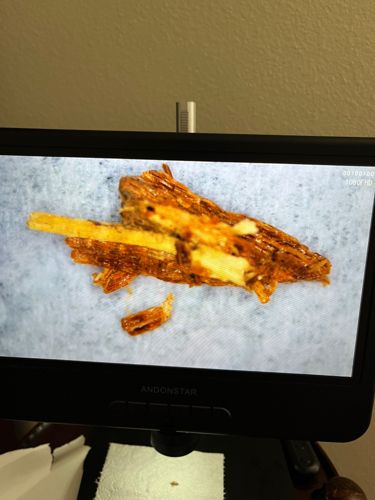Caddisfly (Larval Case)
Scientific Name: Varies by species (e.g., Limnephilus, Leptocerus, Brachycentrus - identification to species level is often difficult from the case alone)
Order & Family: Order: Trichoptera (Caddisflies), Family: Varies widely (e.g., Limnephilidae, Leptoceridae, Brachycentridae, etc., depending on the case type)
Size: Larval cases typically range from 5 mm to 60 mm (0.2 to 2.4 inches) in length, depending on the species and larval instar. The size of the object in the image appears to be in this range, possibly several centimeters long.

Natural Habitat
Caddisfly larvae are primarily aquatic, inhabiting a wide range of freshwater environments including fast-flowing streams, rivers, ponds, and lakes. The specific types of materials used to build their cases often depend on the available resources in their particular aquatic habitat.
Diet & Feeding
Larval caddisflies exhibit diverse feeding behaviors. Some are filter feeders, capturing particles from the water column; others are scrapers, grazing on algae and diatoms from submerged surfaces; and some are predators, consuming small aquatic invertebrates. The appearance of the case in the image, constructed from what looks like plant matter or detritus, suggests detritivorous or herbivorous feeding habits.
Behavior Patterns
Larvae construct protective cases from silk and environmental debris, such as sand grains, tiny pebbles, or plant fragments. They add to their cases as they grow. Most caddisfly larvae are aquatic, living in streams, rivers, and lakes, and attaching their cases to submerged objects. Adults are terrestrial, short-lived, nocturnal, and attracted to light. They do not feed significantly as adults and their primary purpose is reproduction.
Risks & Benefits
Caddisfly larvae are excellent bioindicators of water quality; their presence and diversity indicate a healthy aquatic ecosystem. They play a crucial role in aquatic food webs, breaking down organic matter and serving as a food source for fish and other aquatic organisms. There are no known risks to humans. The object in the image is a larval case, not the insect itself, and is harmless.
Identified on: 9/3/2025